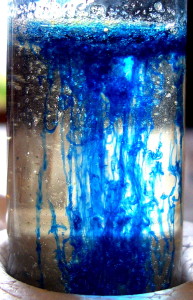
By Hoang-Nam Vu, Staff Writer for Save The Water™ | November 19, 2016
A recent study identified Ferric hexacyanoferrate, or Prussian blue, as a possible solution to brine spills caused by fracking.
Fracking as an energy source
The global need for energy sources is clear. However, there has been much disagreement over the energy sources we should use. One of the most commonly used options is fracking— the process of “oil drilling and hydraulic fracturing.1 Fracking can also alternatively target shale gas formations deep in the ground. The lucrative business of natural gas and oil as an energy source has been said to “create jobs, increase economic activity, manifest a more diverse and stable energy base, and possibly reduce emissions of carbon dioxide, other greenhouse gases, and various other air pollutants (such as mercury).”2
Fracking’s environmental drawbacks
While some praise fracking as an economical godsend in the world of energy, others question its environmental implications. A large issue commonly broached is fracking’s impact on water quality. This includes the presence of “drill cuttings [debris following the breaking of ground and the creation of a borehole] and high-brine produced waters,” which can pollute water sources surrounding the borehole.2 Additionally, it can cause high-brine produced waters, which contain immense amounts of salt, heavy metals, and various toxic compounds utilized in the process of drilling. These waters can include numerous dissolved chemicals drained away from the surrounding rock, including sodium and chloride, heavy metals such as chromium, cobalt, nickel, copper, zinc, arsenic, selenium, silver, cadmium, antimony, mercury, thallium, and lead, radioactive material from buried rock, and others like barium, calcium, and bromide.3 The expulsion of these fluids and chemicals is often referred to as a brine spill.
Brine spills hold vast negative implications for the area surrounding a borehole, particularly concerning the soil. The extreme amount of additional salt added to the land makes it infertile, eliminating its agricultural value. Additionally, the dissolved chemicals can contribute to runoff and lead to general water pollution in the area. The cost of removing these chemicals (in the form of wastewater) can be a heavy monetary burden on fracking companies. Furthermore, if the water gets absorbed by the soil, these problems can extend multiple generations.
Currently, the most prevalent solution is to mitigate the effect that salt in the wastewater has on the soil by having fracking companies “manage the waste through extensive trucking to offsite injection wells.”2 A common solution to alleviate salinity stress on the roots is simply diluting the area with organic materials and cations. However, this solution “can require years to centuries (depending on soil clay content) to remove salt from the root zone.”4 Alternative solutions, such as planting halophytes, may be effective—a study found that numerous species significantly reduced soil salinity when compared to control plots5 — but this solution is overly complicated, expensive, and suboptimal. While natural processes like precipitation may also reduce the salt concentration, there lies a risk of soil absorption, and the alleviation of negative effects is severely delayed. Due to these inadequate processes, there lies a need for a cheap, effective solution with immediate effects to solve the issue of brine spills.
A new solution
A recent study may have found a possible solution to fit this need. Researchers at North Dakota State University have identified the chemical ferric hexacyanoferrate (also known by the name Prussian blue)as a salinity-reducing agent in areas affected by brine spills. In the study, ferric hexacyanoferrate, a crystallization inhibitor, was applied to the surface of brine-contaminated soils; this caused salt to crystallize towards the top of the soil which could be easily harvested. This process resulted in “easy harvest of up to 57% of salts within 7 days without mechanical disturbance to the soil.”4
There are certain issues associated with this solution. First, applying ferric hexacyanoferrate to the surface of brine-affected soil simply makes the salt easier to remove. There still lies a cost in removing the salt itself. Additionally, while the chemical itself is relatively cheap, there may be objections surrounding its efficacy and safety. However, one of the researchers, Aaron Daigh, assured that the chemical “has relatively minimal toxicity towards humans and the environment, is extraordinarily stable, and despite its capacity to yield free-cyanides when decomposed, breaks down slowly and can be neutralized by microbes in the soil.”1
That being said, there is much more to investigate in this topic of study. Researchers suggested the investigation of new methods of deploying crystallization inhibitors for rapid salt extraction as well as loading rate optimization, in-field testing, further investigation of ferric hexacyanoferrate during the remediation process, and the evaluation of other crystallization inhibitors.4 Hopefully, after more research, scientists will be able to more fully identify solutions to the negative effects of brine spills.
References
- American Society of Agronomy & Crop Science Society of America. September 28, 2016. “Solution blooming for fracking spills?” https://www.sciencedaily.com/releases/2016/09/160928140519.htm
- G. A. Burton, et al. July 17, 2014. “Hydraulic ‘Fracking’: Are surface water impacts an ecological concern?” http://onlinelibrary.wiley.com/doi/10.1002/etc.2619/abstract
- L. Song. July 16, 2014. “‘Saltwater’ From Fracking Spill Is Not What’s Found in the Ocean.” http://www.bloomberg.com/news/2014-07-16/-saltwater-from-fracking-spill-is-not-what-s-found-in-the-ocean.html
- A. L. Daigh & A. W. Klaustermeier. February 9, 2016. “Agricultural & Approaching.” https://dl.sciencesocieties.org/publications/ael/pdfs/1/1/150013
- C. H. Keiffer & I. A. Ungar. 2002. “Germination and establishment of halophytes on brine-affected soils.” http://www.academia.edu/15223189/Germination_and_establishment_of_halophytes_on_brine-affected_soils

